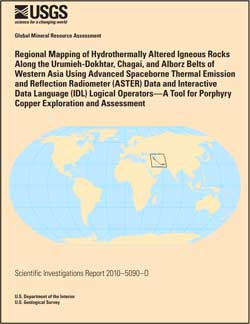 Abstract Abstract
Regional maps of phyllic and argillic hydrothermal alteration were compiled using Advanced Spaceborne Thermal Emission and Reflection Radiometer (ASTER) data and logical operator algorithms. The area mapped extends from northwestern Iran to southeastern Pakistan and includes volcanic and magmatic arcs that make up the Urumieh-Dokhtar volcanic belt (UDVB), the Chagai volcanic belt (CVB), and the central part of the Alborz magmatic belt (AMB). The volcanic belts span the Zagros-Makran transform zone and the present day Baluchistan (Makran) volcanic arc. ASTER visible near infrared (VNIR) data contain three bands between 0.52 and 0.86 micrometers (μm) and the short-wave infrared (SWIR) data consist of six bands spanning 1.6 to 2.43 μm with 15-meter (m), and 30-m resolution, respectively.
During the 8-year project, three different calibration methods were used to correct ASTER SWIR anomalies and produce ASTER calibrated reflectance data, which were then used to map hydrothermally altered rocks. Logical operators, used to map hydrothermally altered rocks, perform multiple band ratios and thresholds that can be applied to multiple ASTER scenes using a single algorithm, thus eliminating separate production and application of vegetation and dark pixel masks. Argillic and phyllic band ratio logical operators use band ratios that define the 2.17- and 2.20-μm absorption features to map kaolinite and alunite, typical in argillized rocks, and muscovite, which is a common mineral in phyllic alteration. Band thresholds for ratios in argillic and phyllic logical operator algorithms were determined by mapping known argillic and phyllic rocks at a calibration test site in Cuprite, Nevada, in the United States.
The regional argillic and phyllic hydrothermal alteration map and geologic and deposit maps of the study area illustrate that distinct patterns of altered rocks are typically associated with certain types of mineral deposits. The central part of the UDVB contains numerous circular to elliptical patterns (1 to 5 kilometers in diameter) of mapped phyllic- and argillic-altered rocks associated with Eocene to Miocene intrusive igneous rocks, some of which host known porphyry copper deposits such as at Meiduk, Sar Cheshmeh, and Seridune in Iran. The Zagros-Makran transform zone and areas adjacent to the Saindak porphyry deposit and Taftan Volcano contain primarily phyllic-altered rocks that form linear patterns associated with extensive faulting and fractures indicative of epithermal and (or) polymetallic vein deposits.
The ASTER alteration map and corresponding geologic maps were used to select circular to elliptical patterns of argillic- and phyllic-altered volcanic and intrusive rocks as potential porphyry copper sites. One hundred and seventy eight potential porphyry copper sites were mapped along the UDVB, and 23 sites were mapped along the CVB. The potential sites were selected to assist in further exploration and assessments of undiscovered porphyry copper deposits.
|
First posted June 26, 2014
Plates from the report are available in low-resolution (smaller file size) and high-resolution (larger file size) formats. Right-click, use "save link as" to avoid opening file in browser window.
Back to Global Mineral Resource Assessment
Part or all of this report is presented in Portable Document Format (PDF). For best results viewing and printing PDF documents, it is recommended that you download the documents to your computer and open them with Adobe Reader. PDF documents opened from your browser may not display or print as intended. Download the latest version of Adobe Reader, free of charge. More information about viewing, downloading, and printing report files can be found here.
|